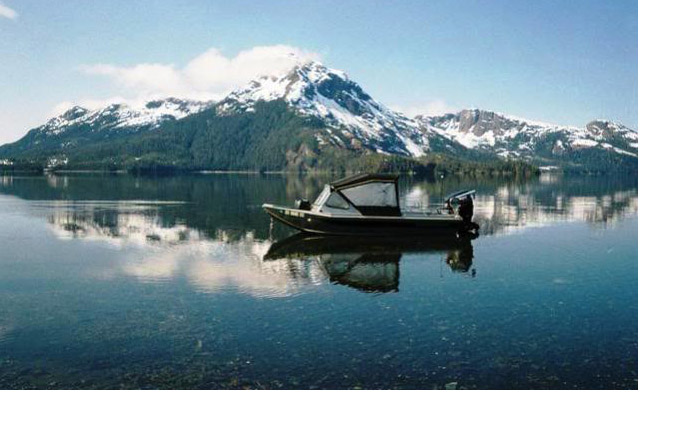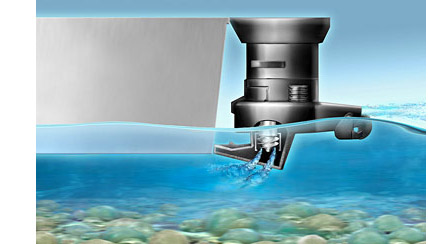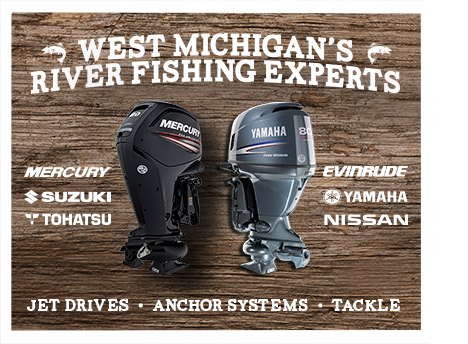 If you chase steelhead or salmon in any one of our river systems, chances are your sled has an outboard jet drive motor on it or you wish it did. Jet drive outboards are the motor of choice for almost every river fisherman for the simple fact that they allow anglers to motor through skinny water that is too shallow for a propped outboard. They also eliminate the chance of damaging a prop and lower unit on unseen hazards such as logs or unexposed rocks. With jet drives becoming more common on rigs in the Midwest, there are a few important factors that should be taken into consideration to achive top performance.
If you chase steelhead or salmon in any one of our river systems, chances are your sled has an outboard jet drive motor on it or you wish it did. Jet drive outboards are the motor of choice for almost every river fisherman for the simple fact that they allow anglers to motor through skinny water that is too shallow for a propped outboard. They also eliminate the chance of damaging a prop and lower unit on unseen hazards such as logs or unexposed rocks. With jet drives becoming more common on rigs in the Midwest, there are a few important factors that should be taken into consideration to achive top performance.
One of the first thngs to think about has to be with the width of the boat. Jets tend to run better on boats with a width of 48” or more. This is because the wider the boat is at the bottom, the higher the hull sits in the water and creates less drag. The second would have to be the weight to power ratio which will determine getting the boat onto plane. Jets are unlike a propped outboard in terms of power because once an outboard is jetted out, it loses 30% of that powerheads original horsepower. There is also no way to play with the RPM’s due to the boat having a heavier payload. When the payload is too heavy on a propped motor, you can simply change to a lower pitched prop so that you can get to the recommended RPM’s for that motor. There is no wiggle room with this on a jet. That's why taking your regular payload into consideration will determine the amount of horsepower needed to power your boat and get it on plane.
 Almost every jet drive pump on the water today, no matter what brand motor, is made by a single company: Outboard Jets out of San Leandro, California. The company was started in 1960 by Dick Stallman, who worked closely with the Wooldridge family to form the product that you know today as the jet drive. Today, Outboard Jets build over 80 different models to fit 6 of the top name outboard manufacturers in the marine industry. One of the things Outboard Jets recommend is that a jet drive motor should be rigged on a boat that has a slight deadrise of 6 - 10 degrees for the best overall performance. This is important because this slight dead rise, or “V”, makes for a smooth ride and splits air filled water before it reaches the jet intake and causes cavitation.
Almost every jet drive pump on the water today, no matter what brand motor, is made by a single company: Outboard Jets out of San Leandro, California. The company was started in 1960 by Dick Stallman, who worked closely with the Wooldridge family to form the product that you know today as the jet drive. Today, Outboard Jets build over 80 different models to fit 6 of the top name outboard manufacturers in the marine industry. One of the things Outboard Jets recommend is that a jet drive motor should be rigged on a boat that has a slight deadrise of 6 - 10 degrees for the best overall performance. This is important because this slight dead rise, or “V”, makes for a smooth ride and splits air filled water before it reaches the jet intake and causes cavitation.
Cavitation can be common occurence in rough waters or harsh conditions as well as those who run a flat bottom sled with no dead rise. With that being said, there are a few solutions to help prevent cavitation from happening. One solution is to install jet intake fins that can be bought as an after market accessory. These fins are not only easy to install, but they can be an economical and simple solution for directing a larger volume of water and reducing the amount of air getting to the intake. They also provide a little more grip in tight turns or rough waters.
Another easy to install solution to cavitation is a transom jack. Transom jacks come in both manual or hydraulic styles and many different sizes. Transom jacks allow you to adjust the height of the motor so that if there is a bit of chop, you can lower it into the water more to get a better intake or water. They also allow you to adjust the intake foot several inches back from the transom for better water flow and efficiency. Some downfalls to transom jacks are that they will add more torque to the transom as well as shift the weight more towards the transom. Because of this weight shift, you may need to adjust your boats load to evenly disperse the weight again.
Outboard jets rely on a constant flow of water that is free of air pockets for them to run efficiently. Boats with keels will carry pockets of air all the way back to the intake causing the jet to run inefficiently. One way around this is to remove a section of the center keel about two feet or so from the stern of the boat. This should create a nice flow of water that is wider than the jet intake.
Another common problem with outboard jets is back spray. This happens when water sprays off of the transom and the foot, which may cause for a wet ride or produce cavitation. This can be fixed by welding an aluminum plate that is just a few inches wider that the intake foot to the transom of the boat where the jet sits. Some of the boat builders acctually fabricate these plates into their original designs.
 The use of outboard jets is definitely on the rise in the Midwest and we will be seeing a lot more of them on the rivers in the years to come. If you are an angler that is thinking about purchasing an outboard jet, these are some great things to keep in mind when looking. Van’s Sport Center sells quite a few new and used jets thoughout the year and our salesman here has quite the experience with them being a river angler himself. Based on your boat and the payload you plan to run, Van’s can get you set up with exactly the right amount of power for the right price so you can get out there and chase some of the greatest trophy fish Michigan has to offer.
The use of outboard jets is definitely on the rise in the Midwest and we will be seeing a lot more of them on the rivers in the years to come. If you are an angler that is thinking about purchasing an outboard jet, these are some great things to keep in mind when looking. Van’s Sport Center sells quite a few new and used jets thoughout the year and our salesman here has quite the experience with them being a river angler himself. Based on your boat and the payload you plan to run, Van’s can get you set up with exactly the right amount of power for the right price so you can get out there and chase some of the greatest trophy fish Michigan has to offer.

